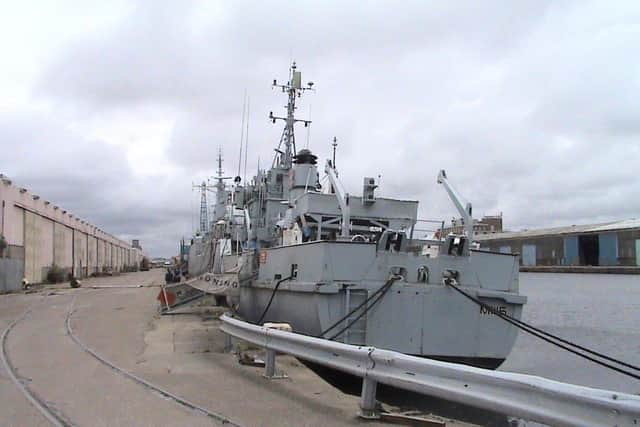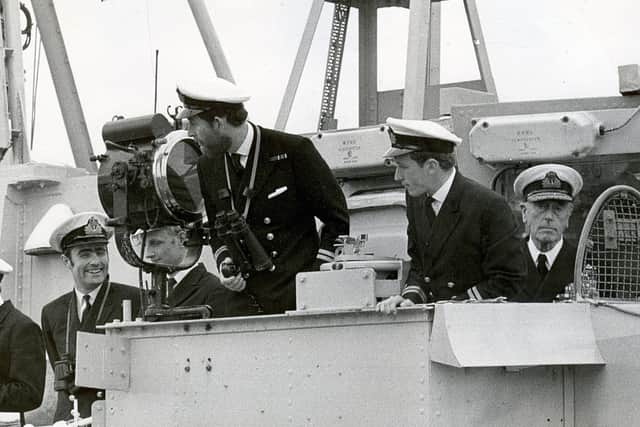Calls to save historic 'last of the wooden walls' Royal Navy warship now submerged in docks
and live on Freeview channel 276
A mahogany-hulled Ton-class minesweeper formerly based in Portsmouth, she is affectionately viewed as among the last of the ‘wooden walls’ representing an ‘important’ part of Great Britain’s naval history.
Yet despite HMS Bronington’s former glories and service to the country in helping maintain peace during the turbulent Cold War era, she has suffered the ignominy of coming to rest destitute, decrepit and submerged in Birkenhead Docks, Merseyside, with little hope of being saved.


Advertisement
Hide AdAdvertisement
Hide AdVarious attempts have been made to save Bronington in the past – by organisations such as the Bronington Trust, of which Prince Charles was the patron.
Yet amid all the doom and gloom, there are calls for Bronington to be ‘saved for the nation’.
Former navy chief weapons engineering artificer Mike McBride, who served on the Ton-class minehunter HMS Iveston between 1987 and 1990, believes there is still hope for the once-proud warship that was based at HMS Vernon in Portsmouth in the 1970s and 1980s.
‘It would be fantastic if she could be saved and proudly displayed at Portsmouth Historic Dockyard along with our other historic ships, but I appreciate financial constraints could well inhibit this unless a benefactor can be found quickly,’ he said.


Advertisement
Hide AdAdvertisement
Hide Ad‘HMS Bronington will be the last of the “wooden walls”, was captained by Prince Charles in 1976 and had important mine clearance roles during the Suez crisis amongst other NATO roles.
‘It was a brilliant achievement in saving the Second World War Landing Craft Tank (LCT) 7074 from a similar fate from Birkenhead Docks.
‘It was recently restored after a multi-million pound restoration project and has now taken pride of place at the D-Day Story Museum.
‘The craft was also a sunken wreck, retrieved from the waters of Birkenhead Docks – what a fantastic achievement that was. And let’s not forget The Mary Rose was a wooden vessel rescued from the depths of the sea centuries later.
Advertisement
Hide AdAdvertisement
Hide Ad‘Bronington would be a significant asset for whoever saves her and would generate huge global publicity.
‘Can the restoration achievements of other vessels be replicated for HMS Bronington before it is too late?’
Naval reservist and Portsmouth North MP Penny Mordaunt certainly hopes so and is even prepared to write to the Royal Family for support alongside lobbying government support for the push to save Bronington.
The MP told The News: ‘This ship is an important part of our naval history and saving her, or giving her a new life as a museum, would be wonderful.
Advertisement
Hide AdAdvertisement
Hide Ad‘There will be huge demands on the public purse at the moment, but if a proposal could be put together that could attract support from private funds I would be happy to ask what the Department for Digital, Culture, Media & Sport could do to help and to write to HRH (Royal Highness) for support.’
Originally commissioned as HMS Humber on June 4, 1954, the vessel was renamed Bronington in 1959 before she was converted into a minehunter at Rosyth Dockyard between 1963 and 1965 where she was initially commissioned to the 5th Minesweeper Squadron and the 1st Mine Countermeasures Squadron on January 5, 1967.
On February 9, 1976, the Prince of Wales took command of the ship for 10 months before departing on December 15.
On November 14 that year, during a visit to the Pool of London, Bronington was visited by the Queen, the Queen Mother and Prince Philip and eight other members of the Royal Family.
Advertisement
Hide AdAdvertisement
Hide AdDuring his stint as captain of the vessel, Prince Charles blended in seamlessly with his shipmates according to Bronington’s former chef Michael Sinker. ‘When you got him to sea without his bodyguards he was just like one of the rest of the crew,’ he told The Telegraph following a reunion party with the Prince at Clarence House in 2011.
As a wooden minesweeper of only 350 tons, she would be prone to swaying leading to widespread sea sickness on board - including Prince Charles who was ‘sick like the rest of us’ and would ‘go on the bridge with a bucket’, the chef added.
In the 1980s, Bronington was deployed to the Mediterranean for minesweeping missions for NATO before paying off in Portsmouth on June 23, 1988.
After being decommissioned from service, the ship was purchased in January 1989 by the Bronington Trust.
Advertisement
Hide AdAdvertisement
Hide AdThe ship was later berthed in the Manchester Ship Canal at Trafford Park, before coming part of the Warship Preservation Trust where she was moored at Birkenhead but fell into decline after the trust’s closure.
By default Bronington became the property of the docks before she sank at her moorings on March 17, 2016.
Bronington is registered on the National Historic Ships, which has provided advice on the vessel to custodians in the years up to her sinking.
‘When it appeared that dismantling the ship was the only viable option, we shared our guidelines with the present custodians,’ a spokeswoman for the organisation said.
Advertisement
Hide AdAdvertisement
Hide Ad‘It is my understanding that, following this, all important material was removed from the ship by the Imperial War Museum, National Museum of the Royal Navy and the Ton Class Association.
‘We recognise that, given her current condition and the previous attempts to find a home for her, it may not be possible to save her.
‘In this scenario, we would urge those dismantling her to record and photograph the process to ensure she is fully documented before being placed on the National Archive of Historic Vessels where her entry will remain, in perpetuity.’
Despite this, saving Bronington for the nation was not totally ruled out. ‘The steps to saving her include identifying a secure home, putting together a long term conservation strategy and securing major funding,’ she said.
Advertisement
Hide AdAdvertisement
Hide Ad‘For Bronington, the funds would have to cover raising her, transporting her to a new location, then carrying out the conservation work. If this is dependent on public monies such as the National Lottery Heritage Fund, it will be important that the vessel is made accessible to the public both during and after the conservation.’
Meanwhile Peter Down, secretary of the Ton Class Association who inspected the ship in 2012 after being given permission by its then de-facto owners Peel Ports, Liverpool, was damning in his assessment of saving the ‘iconic warship’.
He said: ‘At that time, the ship was listing about 10 degrees to starboard, due to flooding of about two or three feet deep in her lower compartments and engineering spaces.
‘It was not safe to venture into them. There were reasons to believe that rot had affected the underwater areas of the ship around the hull valves, allowing water ingress to add to the rainwater penetrating between gaps in the upper deck planking.’
Advertisement
Hide AdAdvertisement
Hide AdThe former minesweeper officer also said ‘weeds and a small tree were growing out of crevices in the upper works’ and there was ‘even excrement in the radio room’.
He declared Bronington was ‘beyond economic repair’ then with ‘full deterioration’ since taking place following her sinking.
In another blow The National Museum of the Royal Navy has ruled out saving her. ‘Whilst we recognise the important role she has played in her years of service we have declined the offer to bring her into our collection of historic ships,’ a spokeswoman said.
‘The 18 historic ships and vessels held by the museum are of international significance, nine of which are recognised by National Historic Ships as part of the National Historic Fleet.
Advertisement
Hide AdAdvertisement
Hide Ad‘The cost for caring for a ship such as these are vast. HMS Bronington would require an enormous financial investment and our priority must be to focus on protecting the incredible ships and collections already in our care.’
The Department for Digital, Culture, Media and Sport was approached for comment.
A message from the Editor, Mark Waldron
Thank you for reading this story. The dramatic events of 2020 are having a major impact on our advertisers and thus our revenues.
The News is more reliant than ever on you taking out a digital subscription to support our journalism. You can subscribe here for unlimited access to Portsmouth news and information online.
Every subscription helps us continue providing trusted, local journalism and campaign on your behalf for our city.
Comment Guidelines
National World encourages reader discussion on our stories. User feedback, insights and back-and-forth exchanges add a rich layer of context to reporting. Please review our Community Guidelines before commenting.